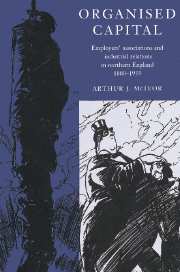Conclusion
Published online by Cambridge University Press: 14 October 2009
Summary
This book has explored a somewhat neglected area of industrial relations history, discussing the emergence of employers' organisations and the labour relations policies formulated by such institutions up to the Second World War. It thus aims to make a contribution to the growing corpus of literature on industrial employers. Recent research has emphasised the variable nature of industrial relations across Britain and stressed the need for more work on the policies of employers at the industry and local levels in order to understand social relations better. The comparative, regional perspective adopted here attempts to address this gap in the literature, providing an alternative focus to the national, single-industry studies that tend to dominate the literature and one that has thrown up some interesting and, I hope, quite meaningful results. At one level, this might be justified on the grounds that an extension of the empirical material available on the genesis, organisation and activities of what remain neglected institutions is welcome. Through absorption in internally generated association records and hence in the day-to-day activities of these organisations we have perhaps got a little nearer to what such bodies actually did, how they were structured, their patterns of growth and policy formulation, and the industrial relations strategies they pursued as they reacted to changing product market, labour market and political circumstances and to the challenge posed by the emergence of organised labour in the late nineteenth and early twentieth centuries.
- Type
- Chapter
- Information
- Organised CapitalEmployers' Associations and Industrial Relations in Northern England, 1880–1939, pp. 270 - 278Publisher: Cambridge University PressPrint publication year: 1996

